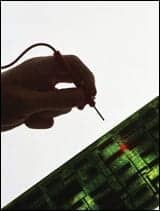By John Noblitt, MAEd, CBET
I often get feedback from the readers of this column about past articles, which they have found useful. This past year—2012—I submitted articles on sequential compression devices and continuous passive motion machines, changes in the test from paper to computer, EC standards, infusion management devices, and a great study aid.
I strive to bring information that is relevant to the test and is, in my best estimation, an area that may be covered on the exam. I also try to provide information that is relevant to study techniques, which may help one to pass the exam. I do hope all the readers find this information helpful in their preparation for the exam, but I know from comments I receive that some articles are more relevant than others.
However, in my opinion, time must be spent on covering information such as the test changing from paper and pencil to computer. The last thing someone needs is a surprise of taking the exam on a computer when you were expecting a paper-and -pencil test. I did receive several comments about this article, as some test takers were not aware of the switch.
SCDs and CPM
Judging from the feedback from different readers, the articles that seemed to be the most helpful for the test this year were the sequential compression devices and continuous passive motion machines, from the February 2012 issue, and the two separate articles that covered infusion management devices (August and October 2012). I had several comments about sequential compression devices and continuous passive motion machines. The most prevalent comment was biomeds knew what they were, but not the clinical benefit of the two therapies. A brief explanation of sequential compression devices, or SCDs, and how they help keep deep vein thrombosis from forming in patients’ legs, can be found in the original article in the 24×7 archives. Continuous passive motion, or CPM, has the clinical benefit of keeping synovial fluid in joints that have been damaged or have had surgery performed on them. If you remember from the article, the synovial fluid brings nutrition to the joint, which helps the joint heal.
To do well on the exam, one must know the difference between pump delivery systems, the different categories of pumps, and how each is used. |
Recapping Infusion Management
The two articles on infusion management devices also brought several comments about the information. Most of the comments received were about not knowing some of the technical terms, such as peristaltic movement, or a worm gear movement used in syringe pumps and anesthesia pumps or epidural pumps. These two articles go into many areas of infusion management devices, such as testing procedures and precautions one must be aware of, such as potential problems with tubing sets and other potential test questions. To do well on the exam, one must know the difference between linear and rotary peristaltic pump delivery systems and the piston-type delivery system.
One must also know the different categories of pumps, such as volumetric pumps, feeding pumps, ambulatory pumps, and PCA pumps, and how each is used in the health care delivery system. These articles also touched on occlusion pressures and problems associated with different pumps used for different patients, such as adult or neonatal pumps, and terms such as “piggybacking” of infusion medications. Again, all this information can found on 24×7’s website.
If you are considering taking the CBET exam in 2013, I strongly suggest you return to these articles for review. When you search “ICC Prep” on the site, you would be well advised to read all the articles found there. There is some great information found in these articles, which I am sure you will find helpful. Now, before we go on to other information, let us see how much information was retained from the 2012 articles. Please take a look at the questions provided to test your knowledge. 24×7 ICC Prep, February 2013
John Noblitt, MAEd, CBET, is the BMET program director at Caldwell Community College and Technical Institute, Hudson, NC. For more information, contact the editor.
|
REVIEW QUESTIONS 1) While performing output verification tests on infusion management devices, you notice each unit is underinfusing. What is your most likely problem? 2) When “piggyback” administration is being used with infusion devices, the most critical programing of the device is the____. 3) What type of infusion management devices allow the patient to control the delivery of solution? 4) Occlusion pressure alarm measurements are made where in relationship to the pump? 5) Hyperventilation can cause a blood disorder known as____? 6) Tocodynamometers measure pressure____. 7) Sequential compression devices are used to inhibit____. 8) CPMs promote which of the following? 9) PCA pumps usually employ what type of delivery mechanism? 10) PICC lines are used in what type of infusion management devices? 11) Piston-type infusion management devices use____to determine how fast the solution is infused. 12) Name the type of infusion management device that allows patients to continue therapy while at home.
Answers: 1–c; 2–c; 3–b; 4–a; 5–d; 6–b; 7–c; 8–d; 9–a; 10–a; 11–b; 12–d.
|




